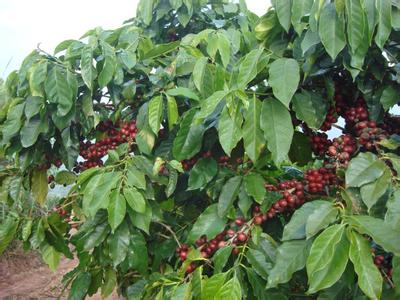A brief introduction to the description of flavor and aroma characteristics of Costa Rican Tarazhu coffee with full grains

Other coffees worth mentioning are JuanVinas,PR, H.Tournon, Windmill,SHB, Montebello and SsntaRosa. Fine coffee is generally grown in Geredia and the central canyon. Another striking type of coffee is Sarchi (one of the five towns that represent Costa Rica's Coffee Road), which grows on the slopes of the PoasVolcano volcano, 53km from San Jose. Saatchi, founded in 1949, has a land area of 30770 hectares and grows sugar cane and coffee. The area is also famous for its handicrafts, attracting tourists from all over the world S.H.B. It is a very hard bean with an altitude of more than 1500 meters above sea level, which means high quality Costa Rican coffee. This extra-hard coffee bean suitable for medium and heavy roasting has a strong sour taste and charming aroma. Costa Rican SHG coffee is usually full of particles, clear flavor, bright acidity and ideal consistency. The strong flavor makes the tail rhyme reverberate in the throat for a long time, which is unforgettable.
Costa Rican coffee has full particles, ideal acidity and unique strong flavor. Costa Rica's coffee industry, originally controlled by the Costa Rican Coffee Industry Company (ICAFE), has been taken over by the official Coffee Committee (Oficinale Cafe). Among the exported coffee, those products that are considered to be of substandard quality are colored with blue vegetable dyes and then transferred back to China for sale. Coffee consumed domestically (dyed blue or undyed) accounts for about 10% of total production, and local per capita coffee consumption is twice as good as that of Italy or the United States. Costa Rican coffee is called "extra hard beans". This kind of coffee can grow at an altitude of more than 1500 meters. Altitude has always been a problem for coffee growers. The higher the altitude, the better the coffee beans, not only because the higher altitude can increase the acidity of the coffee beans and thus increase the flavor, but also because the night temperature at the higher altitude is lower, which can make the trees grow slowly, thus the flavor of the coffee beans is stronger. In addition, due to the high altitude drop caused by sufficient rainfall, it is very beneficial to the growth of coffee trees.
Costa Rican coffee is full of Arabica beans, washed with water, its style is bright, fragrant, clear as wind chimes swaying in the breeze, mild acidity and sweetness. Because of the sweetness, even if the coffee gets cold, it tastes very good, which is a major feature of Costa Rican coffee. Therefore, it is recommended that you taste Costa Rican coffee with only a small amount of sugar and cream in order to enjoy its girlish flavor. Coffee was introduced into Costa Rica from Cuba in 1729. Today, its coffee industry is one of the well-organized industries in the world, with a yield of 1700 kg per hectare. Costa Rica has only 3.5 million people but 400m coffee trees, and coffee exports account for 25 per cent of the country's total exports. Costa Rica's volcanic soil is very fertile and well drained, especially in the central plateau CentralPlateau, where the soil consists of successive layers of ash and dust. Costa Rica was therefore the first country in Central America to grow coffee and bananas for commercial value. Coffee and bananas are the country's main exports. Coffee trees grown in Costa Rica are grown in Arabica, and the quality of coffee beans is better and more stable. In order to facilitate picking, coffee trees are kept at a height of about 2 meters through continuous pruning. The coffee that people eat is the taste of the seeds in the fruit that are brewed in water. After picking raw coffee beans, the seeds (that is, coffee beans) can be roasted only by peeling, pulp, seed film and sun exposure. Part of the process can be replaced by machines, and the speed of coffee production increases a lot. However, there is no machine to do coffee picking, so you must use manual labor.
The topography of Costa Rica is that the coast is surrounded by plains, while the middle is cut off by rugged mountains. The country declared 200 nautical miles in its exclusive economic zone and 12 nautical miles in its territorial sea. The climate belongs to the tropics and subtropics, and some of them are new tropics. Population [edited this paragraph] 4.27 million (2007). The official language is Spanish. 95% of the residents believe in Catholicism. In Costa Rica, only a few Indians survived the western invasion, and now there are only 29000 indigenous people, less than 1% of the total population. Black descendants who emigrated from Jamaica in the 19th century constitute a minority of 3 per cent of the population and about 96000. Mixed-race and purebred Europeans in Costa Rica account for 94%, and the other 1% are Chinese. About 10% of Nicaraguans in Costa Rica, most of them exiled during the civil war. The main immigrants are Germans, Poles, Italians and Jews, and now the number of Indians has increased, mainly due to emigration to Colombia in order to gain access to agricultural workers. In addition, there has been a significant increase in the number of Colombians, Panamanians and Peruvians
All the coffee trees planted in Costa Rica are Arabica coffee trees. through improvement, the quality of coffee beans is better and more stable. in order to facilitate picking, coffee trees are kept at a height of about 2 meters through continuous pruning. The coffee that people eat is the taste of the seeds in the fruit that are brewed in water. After picking raw coffee beans, you must remove the peel, pulp, seed film and sun exposure before roasting the seeds (that is, coffee beans). Part of the process can be replaced by machines, and the speed of coffee production increases a lot, but there is no machine to do it. Be sure to use excellent Costa Rican coffee known as "extra hard beans", which can grow at an altitude of more than 1500 meters. Altitude has always been a problem for coffee growers. The higher the altitude, the better the coffee beans, not only because the higher altitude can increase the acidity of the coffee beans and thus increase the flavor, but also because the night temperature at the higher altitude is lower, which can make the trees grow slowly, thus the flavor of the coffee beans is stronger. In addition, due to the high altitude drop caused by sufficient rainfall, it is very beneficial to the growth of coffee trees.
Costa Rican coffee is full of Arabica beans, washed with water, its style is bright, fragrant, clear as wind chimes swaying in the breeze, mild acidity and sweetness. Because of the sweetness, even if the coffee gets cold, it tastes very good, which is a major feature of Costa Rican coffee. Therefore, it is suggested that when you taste Costa Rican coffee, you should only add a small amount of sugar and cream, so that you can enjoy its girlish flavor.
Important Notice :
前街咖啡 FrontStreet Coffee has moved to new addredd:
FrontStreet Coffee Address: 315,Donghua East Road,GuangZhou
Tel:020 38364473
- Prev

A brief introduction to the treatment method of grinding degree and baking degree of Yunnan small-grain coffee Huaguoshan coffee
The average temperature of Lujiangba in Baoshan is 21.5℃, and the highest is 40.4 ℃, which is basically frost-free all the year round. It is recognized as the best producing area of small-grain coffee. The small-grain coffee cultivated here is famous at home and abroad for its strong but not bitter, fragrant but not strong, well-proportioned small noodles, mellow and fruity. In recent years, the planting area of small-grain coffee in other producing areas of Yunnan has been expanding, and the quality has also made great progress.
- Next

A brief introduction to the History and Culture of the Origin and Development of Tarazhu Fine Coffee in Costa Rica
The coffee produced in Costa Rica is light and sweet in flavor and pleasant in flavor. The excellent Costa Rican coffee is called SHB. The coffee beans here have been carefully processed, and that is why there is high-quality coffee. Costa Rican coffee is full of Arabica beans, washed with water, its style is bright, fragrant, clear as wind chimes swaying in the breeze, and sour
Related
- Detailed explanation of Jadeite planting Land in Panamanian Jadeite Manor introduction to the grading system of Jadeite competitive bidding, Red bid, Green bid and Rose Summer
- Story of Coffee planting in Brenka region of Costa Rica Stonehenge Manor anaerobic heavy honey treatment of flavor mouth
- What's on the barrel of Blue Mountain Coffee beans?
- Can American coffee also pull flowers? How to use hot American style to pull out a good-looking pattern?
- Can you make a cold extract with coffee beans? What is the right proportion for cold-extracted coffee formula?
- Indonesian PWN Gold Mandrine Coffee Origin Features Flavor How to Chong? Mandolin coffee is American.
- A brief introduction to the flavor characteristics of Brazilian yellow bourbon coffee beans
- What is the effect of different water quality on the flavor of cold-extracted coffee? What kind of water is best for brewing coffee?
- Why do you think of Rose Summer whenever you mention Panamanian coffee?
- Introduction to the characteristics of authentic blue mountain coffee bean producing areas? What is the CIB Coffee Authority in Jamaica?

